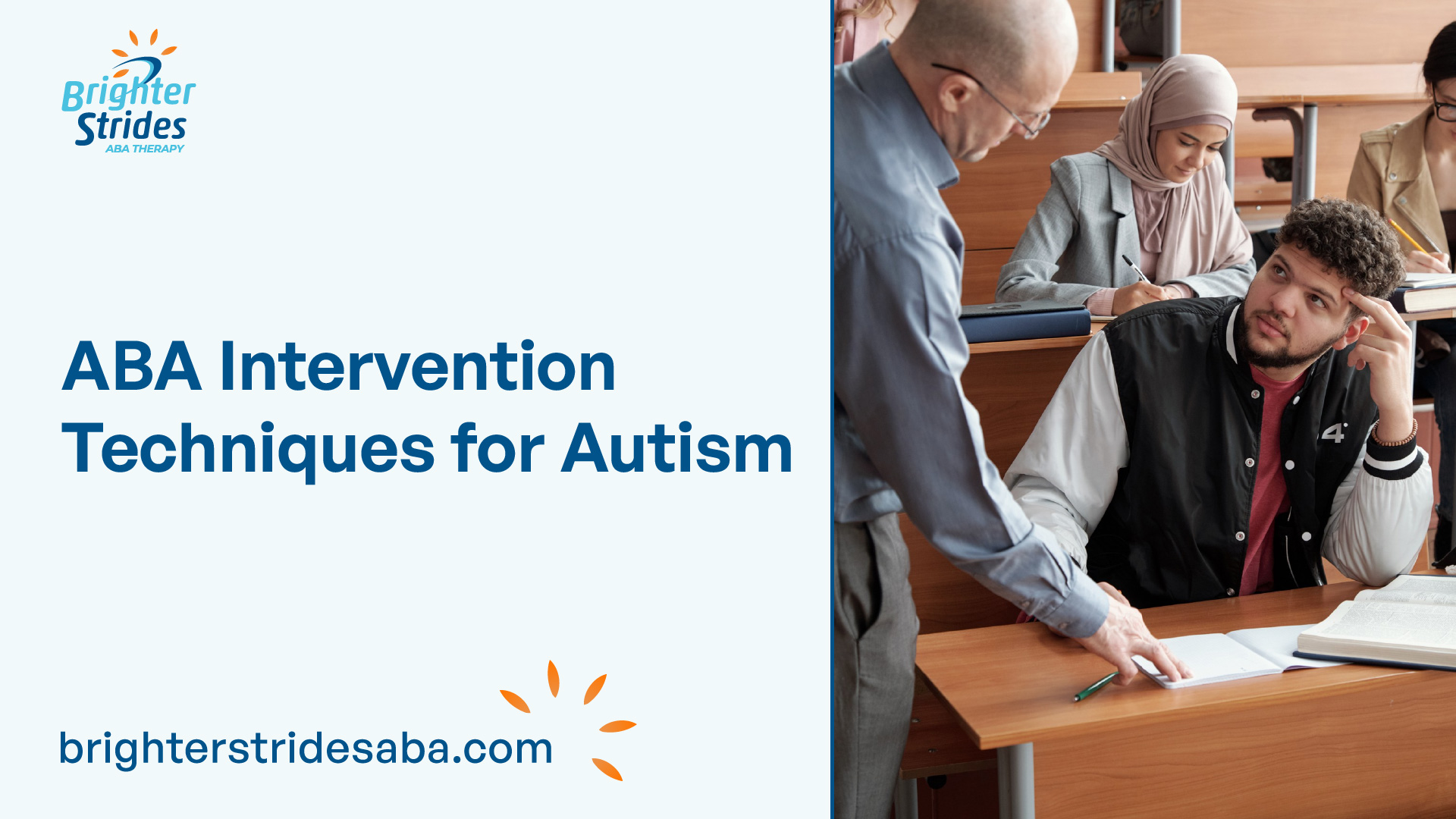
Understanding ABA Therapy
ABA therapy, or Applied Behavior Analysis therapy, has been a cornerstone of intervention techniques for individuals with autism and related developmental disorders since the 1960s. It is considered an evidence-based best practice treatment by the US Surgeon General and the American Psychological Association, supported by more than 20 studies showing its effectiveness in improving outcomes for many children with autism [1].
Basics of ABA Therapy
ABA therapy is based on the work of psychologist B.F. Skinner, who developed a theory of operant conditioning. The therapy focuses on controlling behavior by altering the consequences of that behavior. The main goal of ABA therapy is to increase desired behaviors and decrease problematic behaviors through systematic interventions.
By breaking down complex skills into smaller, achievable steps, ABA therapists utilize various techniques to teach individuals with autism new skills and improve their overall functioning. ABA therapy is highly individualized, taking into account the unique needs and goals of each person.
Principles of ABA Therapy
ABA therapy is grounded in psychological principles, making it a gold standard in behavior modification [3]. The therapy is guided by several core principles:
- Positive Reinforcement: ABA therapists use positive reinforcement to strengthen desired behaviors. By providing rewards, such as praise, tokens, or access to preferred activities, therapists motivate individuals to engage in appropriate behaviors more frequently.
- Setting Behavior Benchmarks: ABA therapy involves setting clear behavior benchmarks or goals. These benchmarks are specific, measurable, achievable, relevant, and time-bound (SMART goals). By breaking down complex skills into smaller, achievable steps, individuals can gradually progress towards the desired outcome.
- Individualized Treatment Plans: ABA therapy recognizes that each individual with autism is unique. Therefore, treatment plans are customized to address specific needs, strengths, and challenges. ABA therapists conduct thorough assessments to identify target behaviors and develop strategies tailored to the individual’s requirements.
By implementing these principles, ABA therapy aims to improve social interaction, communication skills, and adaptive behaviors in individuals with autism. It has proven successful not only in the realm of autism but also in educational settings, therapy sessions for developmental disabilities, and even in organizational behavior management for companies.
Understanding the basics and principles of ABA therapy provides a foundation for exploring the key components and techniques employed in this effective intervention approach.
Read about: What Is ABA Therapy?: The Science Behind Its Success

Key Components of ABA Therapy
ABA therapy, or Applied Behavior Analysis therapy, is a widely recognized and evidence-based intervention for individuals with autism. It involves various key components that contribute to its effectiveness in promoting positive behavior change and skill development. The key components of ABA therapy include positive reinforcement, setting behavior benchmarks, and individualized treatment plans.
Positive Reinforcement
Positive reinforcement is a fundamental strategy utilized in ABA therapy. It involves rewarding desired behaviors to increase the likelihood of their recurrence. In ABA therapy, positive reinforcement can take the form of verbal praise, tokens, or tangible rewards, such as stickers or small treats. By providing positive reinforcement when a child exhibits appropriate behavior or achieves a particular goal, it encourages the repetition of those behaviors over time. This technique helps individuals with autism learn new skills and adapt to their environment more effectively.
Setting Behavior Benchmarks
Another crucial component of ABA therapy is setting behavior benchmarks. ABA therapists establish specific, measurable, and attainable goals for each individual based on their unique challenges and strengths. These benchmarks serve as a guide for tracking progress and determining the effectiveness of the therapy. Behavior benchmarks can be established through assessments, interviews, and observations, taking into account the child’s current abilities and future goals. By setting clear benchmarks, ABA therapists can measure progress and make necessary adjustments to the treatment plan as the child advances or encounters difficulties.
Individualized Treatment Plans
ABA therapy is highly individualized, with treatment plans tailored to meet the specific needs of each child. A board-certified behavior analyst (BCBA) designs and oversees the ABA program, taking into consideration the learner’s skills, interests, preferences, family situation, and developmental level. The treatment plan incorporates evidence-based techniques and strategies, such as discrete trial training (DTT), antecedent-based interventions (ABI), and parent-implemented interventions (PII), which are explored in detail in the next section. By customizing the treatment plan to the unique needs of the child, ABA therapy can address specific challenges and facilitate skill development effectively.
In conclusion, the key components of ABA therapy include positive reinforcement, setting behavior benchmarks, and individualized treatment plans. Positive reinforcement reinforces desired behaviors, behavior benchmarks provide a framework for progress tracking, and individualized treatment plans ensure that therapy is tailored to the specific needs of each child. These components work together to promote positive behavior change, skill development, and improved outcomes for individuals with autism.
Techniques in ABA Therapy
ABA therapy utilizes various techniques to help individuals with autism develop and improve their skills. These techniques are designed to address specific behaviors and promote positive change. Three commonly used techniques in ABA therapy are Discrete Trial Training (DTT), Antecedent-based Interventions (ABI), and Parent-implemented Intervention (PII).
Discrete Trial Training (DTT)
Discrete Trial Training (DTT) is a structured teaching method used in ABA therapy. This technique involves breaking down skills into smaller, manageable components and teaching them in a systematic and repetitive manner. The ABC approach (Antecedent, Behavior, Consequence) is followed during DTT sessions.
During a DTT session, the therapist presents a stimulus or a prompt to the individual, asks for a specific behavior or response, and provides positive reinforcement when the desired behavior is displayed. This process is repeated until the individual can independently perform the behavior without prompts. DTT is particularly effective for teaching new skills and improving existing ones [5].
Read about: Action Behavior Centers: Empowering Individuals to Thrive
Antecedent-based Interventions (ABI)
Antecedent-based Interventions (ABI) focus on modifying the environment to prevent or reduce challenging behaviors. This technique aims to identify and modify antecedents, which are events or circumstances that occur before the behavior of interest. By altering the antecedents, the likelihood of triggering interfering behaviors can be minimized.
ABI techniques include strategies such as offering choices, modifying the physical environment, and providing visual supports. The goal is to create an environment that supports positive behavior and reduces the occurrence of challenging behaviors [2]. ABI is often used in conjunction with other ABA strategies to create a supportive and structured environment for individuals with autism.
Parent-implemented Intervention (PII)
Parent-implemented Intervention (PII) is an important component of ABA therapy, involving the collaboration and training of parents or caregivers. This technique recognizes the significant role that parents play in a child’s development and utilizes their involvement to enhance treatment outcomes.
In PII, parents work closely with ABA therapists to learn and implement ABA strategies and techniques at home. This empowers parents to effectively support their child’s progress and generalize the skills learned during therapy sessions. PII has been shown to be highly effective in improving outcomes for children on the autism spectrum [2].
By incorporating techniques like DTT, ABI, and PII, ABA therapy aims to provide individuals with autism tailored interventions that address their unique needs. These techniques, along with other ABA methods and techniques, contribute to the overall effectiveness of ABA therapy in promoting positive behaviors and improving the quality of life for individuals with autism.
Effectiveness of ABA Therapy
ABA therapy has been widely recognized as an effective intervention for individuals with autism spectrum disorder (ASD). Extensive research has been conducted to evaluate the effectiveness of ABA therapy, particularly in improving socialization and communication skills in individuals with ASD. Let’s explore the research findings in more detail.
Research Findings on ABA
Multiple studies have shown positive outcomes for children who undergo intensive, long-term applied behavior analysis therapy. According to WebMD, children who receive 25 to 40 hours of ABA therapy per week for one to three years demonstrate significant improvements in communication, social skills, and daily living skills.
A comprehensive meta-analysis conducted by NCBI examined the effectiveness of ABA-based interventions on various outcomes in children with ASD. The results of this analysis indicated that ABA therapy had a significant impact on expressive language skills, with a standardized mean difference of d=-3.52 (95% CI -6.31, -0.72). This suggests that ABA therapy can lead to notable improvements in expressive language abilities.
Impact on Socialization and Communication
The same meta-analysis also explored the impact of ABA therapy on socialization and communication skills. For the outcome of socialization, the analysis showed a standardized mean difference of d=0.11 (95% CI -0.31, 0.54), indicating a positive but not statistically significant effect. However, it’s important to note that the analysis found no significant difference in the effectiveness of ABA therapy compared to other interventions, such as PECS (Picture Exchange Communication System) or ESDM (Early Start Denver Model), in terms of socialization outcomes.
Regarding communication skills, the meta-analysis revealed a standardized mean difference of d=0.30 (95% CI -0.02, 0.61), suggesting a potential positive effect of ABA therapy. However, similar to socialization outcomes, no significant differences were found when comparing the effectiveness of ABA therapy with other interventions such as PECS or ESDM.
It’s important to note that the effectiveness of ABA therapy can vary depending on individual factors such as age, severity of symptoms, and treatment duration. Additionally, each person’s response to therapy may differ. ABA therapy should be individualized and tailored to meet the specific needs of each individual with autism spectrum disorder.
Through ongoing research and continued advancements in the field, ABA therapy continues to evolve and refine its techniques to provide the most effective interventions for individuals with ASD. The focus on improving socialization and communication skills remains crucial in enhancing the quality of life for individuals with autism spectrum disorder.

Evolution of ABA Therapy
ABA therapy has a rich historical background and has evolved significantly since its inception in the 1960s. Over the years, it has demonstrated its versatility and applications in various fields beyond autism treatment. This section will delve into the historical background of ABA therapy and explore its versatility and applications.
Historical Background
ABA therapy has been used to help children with autism and related developmental disorders since the 1960s. It was initially developed by psychologist Dr. Ole Ivar Lovaas, who implemented intensive behavioral interventions to address the specific needs of children with autism [1]. Since then, ABA therapy has continued to evolve, incorporating new techniques, strategies, and teaching methods.
Over the past 60 years, ABA therapy has seen significant advancements. It has transitioned from the core principles established in the early Lovaas model to more comprehensive treatment models and focused intervention practices. These models and practices aim to address deficits in cognition, language, social skills, problem behavior, and daily living skills for individuals with autism spectrum disorder (ASD) across all levels of functioning.
Read about: Decoding the Lovaas Method of ABA Therapy
Versatility and Applications
While ABA therapy is primarily known for its success in treating individuals with autism, its versatility extends beyond autism treatment. ABA techniques and strategies can be applied in various settings and contexts. Here are some of the areas where ABA therapy has proven to be effective:
- Educational Settings: ABA techniques can be implemented in educational settings to support learning and skill development. From structured teaching methods to behavior management strategies, ABA principles can enhance educational outcomes for individuals with autism and other developmental disabilities.
- Therapy Sessions for Developmental Disabilities: ABA therapy can be utilized in therapy sessions for individuals with developmental disabilities other than autism. By tailoring treatment plans to address specific needs, ABA techniques can help individuals improve their functional skills, communication, and social interactions.
- Organizational Behavior Management (OBM): ABA principles have found applications in organizational behavior management. By using behavior analytic techniques, professionals can shape and modify behavior in a workplace setting, improving productivity and efficiency.
The versatility and adaptability of ABA therapy have allowed it to extend its reach beyond autism treatment. Its evidence-based nature and focus on behavior change make it a valuable tool in various domains.
As ABA therapy continues to evolve, researchers and practitioners are constantly developing new methods, techniques, and teaching strategies to address the diverse needs of individuals with autism and related developmental disorders. The ongoing advancements in ABA therapy contribute to improved outcomes and quality of life for those receiving treatment.
In the next section, we will explore the importance of individualization in ABA therapy and how customized treatment plans and tailored learning approaches play a vital role in maximizing the effectiveness of interventions.
Individualization in ABA Therapy
ABA therapy is highly individualized and tailored to meet the unique needs and goals of each client. This individualization allows for the empowerment of a child’s unique strengths and personalities to shine through [8]. Let’s explore two key aspects of individualization in ABA therapy: customized treatment plans and tailored learning approaches.
Customized Treatment Plans
Individualization in ABA therapy begins during the assessment process, which includes interviews with caregivers, client observation, and direct assessments. This initial evaluation helps identify specific areas of strength and areas for growth in each child [8].
Based on assessments, interviews, and observations, goals in ABA therapy are created specific to the child’s current abilities and future goals. These goals are measurable, time-bound, and agreed upon between ABA therapy clinicians and caregivers. Customized treatment plans ensure that the intervention targets the specific needs of each child, allowing for progress across multiple skills [8].
To better understand the progress being made, data is collected and analyzed regularly. This data-driven approach helps inform adjustments to the treatment plan, ensuring that it remains tailored to the child’s evolving needs. By continually reassessing and modifying the treatment plan, ABA therapy can effectively address the unique challenges and goals of each child.
Tailored Learning Approaches
In ABA therapy, the way a child learns is individualized to their preferred learning style. Board Certified Behavior Analysts (BCBAs) work closely with each client to understand their unique needs and preferences, allowing for teaching approaches to be tailored accordingly. This personalized approach to teaching ensures that the child can effectively acquire and generalize new skills.
To accommodate different learning styles, ABA therapy employs various teaching techniques and strategies. These may include visual supports, verbal prompts, modeling, and hands-on activities. By adapting the teaching methods to match the child’s preferred learning style, ABA therapy maximizes the child’s engagement and ability to learn.
Furthermore, the schedule of ABA therapy sessions is individualized based on the child’s needs. Some children may require 10 hours per week, while others may need up to 40 hours per week to make progress towards their goals. The number and frequency of sessions are determined based on the child’s unique circumstances and treatment objectives [8].
By emphasizing customized treatment plans and tailored learning approaches, ABA therapy ensures that each child receives the targeted support they need to reach their full potential. Through individualized interventions, children with autism can make significant progress in various areas, including communication, socialization, and daily living skills.




